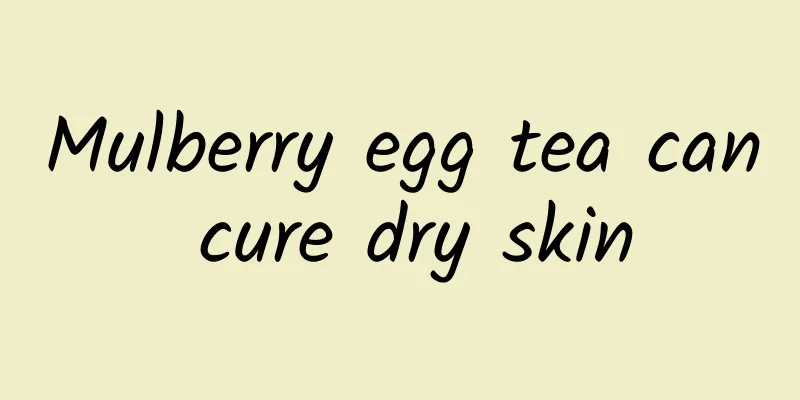Mulberry egg tea can cure dry skin

|
Mistletoe, a common Chinese medicine, has many unexpected functions. So how much do you know about mistletoe? What are the uses and indications of mistletoe? How to identify mistletoe? In addition, how much do you know about mistletoe egg tea? Please see the introduction below. Mistletoe, also known as mistletoe, northern parasite, and wide parasite (Mistletoe). Source: 1. Mistletoe is the dried leafy stems and branches of the evergreen parasitic shrub Viscum alba of the Morus altissima family. 2. The dried leafy stems and branches of the evergreen parasitic shrub Morus alba of the Mossaceae family. Origin: Mistletoe is mainly produced in Hebei, Northeast China, Inner Mongolia, Anhui, Henan and other provinces. Mistletoe is mainly produced in Guangdong and Guangxi; it is also produced in Yunnan, Guizhou and other provinces. Identification of properties: 1. Mistletoe; the stems are cylindrical, about 30 cm long and 0.3~1 cm wide. Yellow-green in color, with swollen nodes and wrinkles all over. The leaves are opposite at the forked apex, oblanceolate, thick, usually three-veined, and slightly shiny. It is light and brittle and easy to break. The cross section is yellow-green, the wood is lighter in color with radial patterns, and the pith is obvious. It has a faint smell, slightly bitter taste, and becomes sticky when chewed. 2. Miscanthus sinensis (Lossilifolia); the stems and branches of Lossilifolia are slender and cylindrical, similar to cassia twigs, with a reddish-brown outer skin with countless tiny spots (lenticels), and the young branches have fine brown hairs. It is hard, woody, and not easy to break. The bark of the cross section is reddish-brown, the wood is lighter in color, and there is a small pith in the center which is darker in color. The leaves are mostly fallen, leathery and slightly brittle, oval, yellowish brown, and without serrations. It has a faint smell and a bitter taste. The best ones are those with thin branches, tender texture, reddish-brown color and leaves. The efficacy and function of mistletoe Pharmacological action: 1. Antihypertensive; the extract has the effect of lowering blood pressure, and the point of action is on the internal receptors, causing antihypertensive reflex, or due to the inhibition of the vasomotor center of the medulla oblongata or spinal cord. But the effect is short-lived and not lasting. 2. Cholesterol lowering: Preliminary results of clinical trials show that it seems to have a certain effect on lowering serum cholesterol. 3. Diuretic: The effect is quite significant, and the active ingredient is glabradine. Nature and flavor: bitter and flat. Meridians: Enters the liver and kidney meridians. Function: Nourishes the liver and kidneys, eliminates rheumatism, strengthens the muscles and bones, nourishes blood and stabilizes the fetus. Indications: pain in waist and knees. Weak muscles and bones, fetal movement and fetal leakage. Clinical Application: 1. Treatment of hypertension. It is suitable for cases of liver and kidney deficiency, yin deficiency and yang hyperactivity, headache, dizziness, tinnitus, and palpitations. It has a blood pressure lowering effect. 30-60g can be used alone, decocted in water instead of tea, but because of its limited strength, it is often used with blood-drying herbs such as raw rehmannia, red peony root, and honeysuckle vine, etc., decocted in water and taken orally. Recipes such as Sangji Antihypertensive Decoction have a certain effect on lowering blood pressure and improving symptoms. 2. Treat rheumatic arthritis. It is suitable for patients with rheumatic arthritis, rheumatic myositis, low back pain, and other symptoms of blood deficiency. It has the effects of harmonizing blood vessels, relaxing muscles and tendons, and relieving pain. It is often used with Angelica dahurica, Rehmannia glutinosa, Saposhnikovia divaricata, Codonopsis pilosula, etc. 3. Treat dry skin, also known as "dry skin" in traditional Chinese medicine. It is caused by blood deficiency and blood stasis. Because the blood cannot nourish the skin, the skin becomes dry and even like fish scales. Previous generations believed that mistletoe can "lighten the skin" and therefore can treat this disease, but its mechanism of action needs further study. The usage is to take 30-60g of mistletoe each time, add an egg and appropriate amount of sugar, and decoct in water. |
<<: Ginger potato introduction
>>: Introduction to ginger essential oil
Recommend
After the Big Bang, there was another Dark Bang…
This is a picture of the galaxy cluster Cl0024+16...
What are the effects and functions of Pueraria lobata?
Pueraria root is a good Chinese medicinal materia...
Six pictures! Help you understand the "high-frequency synonyms" in this round of epidemic prevention and control
Venue code and health code, antigen test and nucl...
If you are anxious and emotionally drained, you might as well use poetry to heal yourself
© TED Ideas Leviathan Press: This kind of tinglin...
What are the medicinal values of lotus incense?
I believe everyone is familiar with lotus leaves....
Today is the beginning of winter丨Autumn is over and winter is coming
Today 18:45 We usher in the first solar term of w...
What are the effects of the traditional Chinese medicine Cistanche deserticola
Cistanche has extremely high medicinal value and ...
Why can't astronauts get out of the return capsule right away after returning to Earth? Why do they have to lie down after leaving the capsule?
Friends who have watched the live broadcast of th...
In future wars, small animals can also play a big role
Humans are the only intelligent creatures on Eart...
The efficacy and function of stone vine
Stone vine is something that many people are very...
Can Gynostemma pentaphyllum lower blood lipids?
You may not have heard of Gynostemma pentaphyllum...
What diseases can be treated with the medicinal value of plantain?
Plantain is a kind of Chinese herbal medicine and...
What are the effects of drinking Astragalus soaked in water?
We need to drink water every day, which will help...
Radio Gymnastics is 70 years old! Are there any young you in these photos?
Every day at noon Sitting in the office I can hea...
The efficacy and function of female golden reed
I believe many people are familiar with the Chine...









